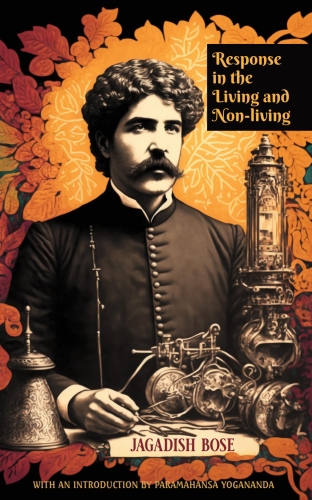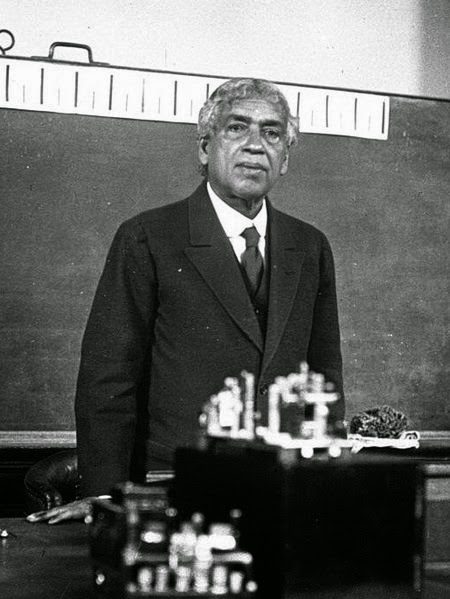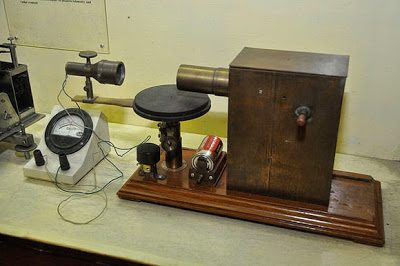
AMAZON PAPERBACK | US | Australia | Germany | Spain | Italy | Netherlands | Poland | Sweden | Japan | Canada | UK
PAPERBACK ELSEWHERE | Book Depository | Booktopia | Book Depository | Fishpond
AMAZON KINDLE | US | UK | Germany | France | Spain | Italy | Netherlands | Japan | Brazil | Canada | Mexico | Australia | India
EBOOK ELSEWHERE | Google | Lulu
EBOOK HERE | PDF | Epub
DOWNLOAD SAMPLE PDF
JAGADISH CHANDRA BOSE was born on November 30, 1858, Mymensingh, Bengal, India (now in Bangladesh), and died on November 23, 1937, Giridih, Bihar. His work as both a physiologist and physicist led to the invention of highly sensitive instruments for the detection of minute responses by living organisms to external stimuli. This enabled him to measure the similarities in response between animal and plant tissues noted by many later researchers.
Bose’s experiments on the quasi-optical properties of very short radio waves led him to make improvements on the coherer, an early form of radio detector, which contributed to the development of solid-state physics.
After earning a degree from the University of Cambridge (1884), Bose served as professor of physical science (1885–1915) at Presidency College, Calcutta. In 1917, he founded the Bose Institute in Calcutta, which still exists today (www.jcbose.ac.in).
To facilitate his research, he constructed automatic recorders capable of registering extremely slight movements; these instruments produced some striking results, such as his demonstration of the sense of feeling in plants.
Bose also found that non-living matter exhibits the same types of response to stimuli as do both animal and plant matter. This demonstration that everything exists in the field of consciousness was one of his most important discoveries.
Bose was one of the first scientists in the world to undertake interdisciplinary research by looking at plants from the vantage point of physics.
He subjected plant and animal tissues to various kinds of stimulus, and found that they all showed an electric response. Finding that this reaction occurred in metals as well as plants and animals, he then proceeded to study the differences in response under various conditions.
He found that all materials are numbed by cold, intoxicated by alcohol, wearied by excessive work, stupefied by anesthetics, excited by electric currents, stung by physical blows, and killed by poison. They all exhibit essentially the same reactions of fatigue and depression, together with the capacity for recovery and strength, and also permanent unresponsiveness, or death. All materials are responsive or unresponsive under the same conditions and in the same manner.
His investigations showed that in the entire range of responses—regardless of whether the subject is metallic, plant or animal—there are no exceptions. The living response, in all its diverse modifications, is a repetition of the responses seen in the inorganic. Further, the nature of the response is determined not by the play of an unknowable and arbitrary vital force, but by laws that do not change, and act equally and uniformly throughout both organic and inorganic matter.
This realization was always at the core of his work. He sought to show that all materials react to their environments according to the same laws; in other words, everything exists in the same field of consciousness. Om Namah Shivaya.
This book was originally published in 1902.
Below: Jagadish Bose demonstrating his wireless millimeter-wave (microwave) experiments at the Royal Institution, London in January 1897. This predates the wireless experiments of Marconi, to whom the Nobel prize was however awarded.

Bose worked in the later 1800s and early 1900s. Because he was Indian, he was largely ignored in the UK, although he did study and teach there. You can read about his life on his Wikipedia page.

Bose undertook an examination of inorganic matter in the same way as a biologist examines a muscle or a nerve. He subjected metals to various kinds of stimulus-mechanical, thermal, chemical, and electrical. He found that all sorts of stimulus produce an excitatory change in them. This excitation sometimes expresses itself in a visible change of form, and sometimes not; but the disturbance produced by the stimulus always exhibits itself as an electric response.
His investigations showed that, in the entire range of response phenomena (regardless of whether the subject is metallic, plant or animal in origin) there is no breach of continuity; that “the living response in all its diverse modifications is only a repetition of responses seen in the inorganic”.
The phenomena of response “…are determined, not by the play of an unknowable and arbitrary vital force, but by the working of laws that know no change, acting equally and uniformly throughout the organic and inorganic matter.”
“One of the most important scientists of the 20th century is a little known Indian, Sir Jagadis Chandra Bose. He was trained in England and spent most of his life working in the realm of physics and applied biology, namely botany and plant physiology. His works, sadly ignored largely by the west, mark some of the greatest achievements of the century. He demonstrated wireless transmission before Marconi and created a number of sensitive measuring devices based on optics which revealed the most micro growth movements of plants. He achieve a magnification factor of some 25,000 times, using equipment he had designed and made, with the help of an illiterate tin smith. This work outlines some of his greatest work, the thin line between living and non-living material. This timely reprint is a testament to a remarkable man whose achievements in science beggar belief to this day. While produced photographically from the original text, it still reproduces a quality book written in the unique style of one of our greatest scientists of yesteryear. That such great works are not only preserved, but republished for a new generation to read and enjoy is a tribute to the publishers. Highly recommended for any reader interested in the fascinating history of the pursuit of knowledge. 5 stars.”
– Reader review
Contents
- Introduction by Paramahansa Yogananda
- 1. The mechanical response of living substances | Mechanical response – Different kinds of stimuli–Myograph – Characteristics of response curve: period, amplitude, form – Modification of response curves
- 2. Electric response | Conditions for obtaining electric response – Method of injury – Current of injury – Injured end, cuproid: uninjured, zincoid – Current of response in nerve from more excited to less excited – Difficulties of present nomenclature – Electric recorder – Two types of response, positive and negative – Universal applicability of electric mode of response – Electric response a measure of physiological activity – Electric response in plants
- 3. Electric response in plants – method of negative variation | Negative variation – Response recorder – Photographic recorder – Compensator – Means of graduating intensity of stimulus – Spring tapper and torsional vibrator – Intensity of stimulus dependent on amplitude of vibration – Effectiveness of stimulus dependent on rapidity also
- 4. Electric response in plants – block method | Method of block – Advantages of block method – Plant response a physiological phenomenon – Abolition of response by anæsthetics and poisons – Abolition of response when plant is killed by hot water
- 5. Plant response – on the effects of single stimulus and of superposed stimuli | Effect of single stimulus – Superposition of stimuli – Additive effect – Staircase effect – Fatigue – No fatigue when sufficient interval between stimuli – Apparent fatigue when stimulation frequency is increased – Fatigue under continuous stimulation
- 6. Plant response – on diphasic variation | Diphasic variation – Positive after-effect and positive response – Radial E.M. variation
- 7. Plant response – on the relation between stimulus and response | Increased response with increasing stimulus – Apparent diminution of response with excessively strong stimulus
- 8. Plant response – on the influence of temperature | Effect of very low temperature – Influence of high temperature – Determination of death-point – Increased response as after-effect of temperature variation – Death of plant and abolition of response by the action of steam
- 9. Plant response – effect of anæsthetics and poisons | Effect of anæsthetics, a test of vital character of response – Effect of chloroform – Effect of chloral – Effect of formalin – Method in which response is unaffected by variation of resistance – Advantage of block method – Effect of dose
- 10. Response in metals | Is response found in inorganic substances? – Experiment on tin, block method – Anomalies of existing terminology – Response by method of depression – Response by method of exaltation
- 11. Inorganic response – modified apparatus to exhibit response in metals | Conditions of obtaining quantitative measurements – Modification of the block method – Vibration cell – Application of stimulus – Graduation of the intensity of stimulus – Considerations showing that electric response is due to molecular disturbance – Test experiment – Molecular voltaic cell
- 12. Inorganic response – method of ensuring consistent results | Preparation of wire – Effect of single stimulus
- 13. Inorganic response – molecular mobility: its influence on response | Effects of molecular inertia – Prolongation of period of recovery by overstrain – Molecular model – Reduction of molecular sluggishness attended by quickened recovery and heightened response – Effect of temperature – Modification of latent period and period of recovery by the action of chemical reagents – Diphasic variation
- 14. Inorganic response – fatigue, staircase, and modified response | Fatigue in metals – Fatigue under continuous stimulation – Staircase effect – Reversed responses due to molecular modification in nerve and in metal, and their transformation into normal after continuous stimulation – Increased response after continuous stimulation
- 15. Inorganic response – relation between stimulus and response – superposition of stimuli | Relation between stimulus and response – Magnetic analogue – Increase of response with increasing stimulus – Threshold of response – Superposition of stimuli – Hysteresis
- 16. Inorganic response – effect of chemical reagents | Action of chemical reagents – Action of stimulants on metals – Action of depressants on metals – Effect of ‘poisons’ on metals – Opposite effect of large and small doses
- 17. On the stimulus of light and retinal currents | Visual impulse: (1) chemical theory; (2) electrical theory – Retinal currents – Normal response positive – Inorganic response under stimulus of light – Typical experiment on the electrical effect induced by light
- 18. Inorganic response – influence of various conditions on the response to stimulus of light | Effect of temperature – Effect of increasing length of exposure – Relation between intensity of light and magnitude of response – After-oscillation – Abnormal effects: (1) preliminary negative twitch; (2) reversal of response; (3) transient positive twitch on cessation of light; (4) decline and reversal – Résumé
- 19. Visual analogues | Effect of light of short duration – After-oscillation – Positive and negative after-images – Binocular alternation of vision – Period of alternation modified by physical condition – After-images and their revival – Unconscious visual impression.
- 20. General Survey and Conclusion

Be the first to comment